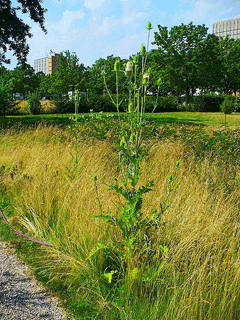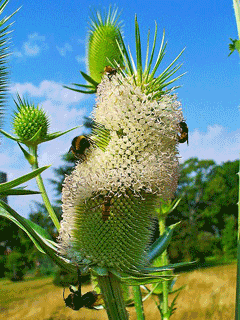 |
|
http://commons.wikimedia.org/wiki/User:Llez |
 |
| http://commons.wikimedia.org/wiki/User:Llez |
Translate this page:
Summary
Physical Characteristics

 Dipsacus sativus is a BIENNIAL/PERENNIAL growing to 1.8 m (6ft).
Dipsacus sativus is a BIENNIAL/PERENNIAL growing to 1.8 m (6ft).
See above for USDA hardiness. It is hardy to UK zone 5 and is not frost tender. It is in flower from July to August, and the seeds ripen from August to October. The species is hermaphrodite (has both male and female organs) and is pollinated by Bees. The plant is self-fertile.
It is noted for attracting wildlife.
Suitable for: light (sandy), medium (loamy) and heavy (clay) soils and can grow in heavy clay soil. Suitable pH: mildly acid, neutral and basic (mildly alkaline) soils. It cannot grow in the shade. It prefers moist soil.
UK Hardiness Map
US Hardiness Map
Synonyms
D. fullonum sativus.
Plant Habitats
Cultivated Beds;
Edible Uses
References More on Edible Uses
Medicinal Uses
Plants For A Future can not take any responsibility for any adverse effects from the use of plants. Always seek advice from a professional before using a plant medicinally.
Cancer Diaphoretic Diuretic Homeopathy Stomachic Warts
The root is diaphoretic, diuretic and stomachic[7]. An infusion is said to strengthen the stomach, create an appetite, remove obstructions of the liver and treat jaundice[4]. The root is harvested in early autumn and dried for later use[7]. The plant has a folk history of use in the treatment of cancer, an ointment made from the roots is used to treat warts, wens and whitlows[4, 218]. A homeopathic remedy is made from the flowering plant[7]. It is used in the treatment of skin diseases[7].
References More on Medicinal Uses
The Bookshop: Edible Plant Books
Our Latest books on Perennial Plants For Food Forests and Permaculture Gardens in paperback or digital formats.

Edible Tropical Plants
Food Forest Plants for Hotter Conditions: 250+ Plants For Tropical Food Forests & Permaculture Gardens.
More

Edible Temperate Plants
Plants for Your Food Forest: 500 Plants for Temperate Food Forests & Permaculture Gardens.
More

More Books
PFAF have eight books available in paperback and digital formats. Browse the shop for more information.
Shop Now
Other Uses
Brush Dye
The dried flower heads are used for carding wool and as a clothes brush for raising the nap on woollen cloth[7, 46, 74, 169]. They are harvested with about 20cm of stem as soon as the flowers wither and are dried for later use[4]. A blue dye is obtained from the dried plant, an indigo substitute[74]. It is water soluble[74]. The colour is yellow when mixed with alum[148].
Special Uses
Attracts Wildlife
References More on Other Uses
Cultivation details
Succeeds in most soils[1] but prefers clay[17]. Prefers a deep rich soil[169]. Requires a sunny position[169]. A good butterfly plant[24]. Fuller's teasel is occasionally cultivated for its seed head, which is used for carding cloth[1, 2, 46]. The flowering heads are also much prized by flower arrangers because they keep their colour almost indefinitely when dried[7].
References Carbon Farming Information and Carbon Sequestration Information
Temperature Converter
Type a value in the Celsius field to convert the value to Fahrenheit:
Fahrenheit:
The PFAF Bookshop
Plants For A Future have a number of books available in paperback and digital form. Book titles include Edible Plants, Edible Perennials, Edible Trees,Edible Shrubs, Woodland Gardening, and Temperate Food Forest Plants. Our new book is Food Forest Plants For Hotter Conditions (Tropical and Sub-Tropical).
Shop Now
Plant Propagation
Seed - best sown in early spring in situ[115]. The seed can also be sown from February to May or from August to October. All but the earlier sowings can be made outdoors.
Other Names
If available other names are mentioned here
Indian teasel
Native Range
Coming Soon
Weed Potential
Right plant wrong place. We are currently updating this section.
Please note that a plant may be invasive in one area but may not in your area so it's worth checking.
This plant can be weedy or invasive. Noxious Weed Information: Iowa, US (teasel):
Secondary noxious weed.
Conservation Status
IUCN Red List of Threatened Plants Status : This taxon has not yet been assessed.

Growth: S = slow M = medium F = fast. Soil: L = light (sandy) M = medium H = heavy (clay). pH: A = acid N = neutral B = basic (alkaline). Shade: F = full shade S = semi-shade N = no shade. Moisture: D = dry M = Moist We = wet Wa = water.
Now available:
Food Forest Plants for Mediterranean Conditions
350+ Perennial Plants For Mediterranean and Drier Food Forests and Permaculture Gardens.
[Paperback and eBook]
This is the third in Plants For A Future's series of plant guides for food forests tailored to
specific climate zones. Following volumes on temperate and tropical ecosystems, this book focuses
on species suited to Mediterranean conditions—regions with hot, dry summers and cool, wet winters,
often facing the added challenge of climate change.
Read More
Expert comment
Author
(L.)Honck.
Botanical References
200
Links / References
For a list of references used on this page please go here
Readers comment